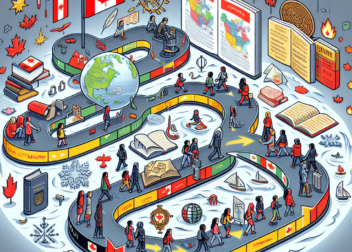Canada’s reputation as a welcoming and inclusive nation is reinforced by its ambitious new immigration targets for 2024 to 2026. Recognizing the importance of immigration to support economic growth, address demographic challenges, and enrich cultural diversity, Canada aims to welcome over 1.2 million newcomers in the coming years. If you are planning to make Canada your new home, here’s a detailed look at the latest immigration policies and pathways to help you prepare for your journey.

Canada’s Revised Immigration Targets
The Canadian government has adjusted its immigration targets to reflect the growing demand for skilled labor and compensate for an aging population. The updated targets are as follows:
- 2024: 401,000 new permanent residents
- 2025: 411,000 new permanent residents
- 2026: 421,000 new permanent residents
These numbers represent a significant increase from previous years, emphasizing the country’s focus on sustainable economic growth and workforce expansion. With immigration accounting for over 75% of Canada’s population growth, this strategy ensures that the country maintains its competitive edge in the global economy.
The immigration plan primarily focuses on economic immigrants, with approximately 60% of the new arrivals coming through programs designed to meet labor market needs. However, Canada also remains committed to family reunification and humanitarian efforts, reinforcing its reputation as a global leader in both economic and compassionate immigration.
Key Immigration Pathways
Canada offers multiple immigration pathways to accommodate individuals with diverse skills, backgrounds, and needs. Here’s a breakdown of the major programs through which immigrants can become permanent residents:
- Express Entry System:
The Express Entry system remains the primary pathway for skilled immigrants, managing applications through three major streams:- Federal Skilled Worker Program (FSWP)
- Canadian Experience Class (CEC)
- Federal Skilled Trades Program (FSTP)
- Provincial Nominee Program (PNP):
The PNP offers overseas workers the chance to settle in specific provinces that are facing labor shortages. Each province has its own nomination criteria, focusing on the skills and experience most needed in the local economy. - Family Class Sponsorship:
Canadian citizens and permanent residents can sponsor spouses, children, parents, and siblings for permanent residency. This pathway strengthens family bonds and aligns with Canada’s commitment to family reunification. - Refugees and Protected Persons Class:
Canada also provides protection to individuals fleeing conflict or persecution. The government has promised to increase the number of refugee admissions, further reflecting its humanitarian values.
Opportunities in Rural and Northern Communities

Recognizing the labor shortages in rural areas, Canada has introduced targeted programs to attract immigrants to rural and northern regions:
- Rural and Northern Immigration Pilot (RNIP): Encourages skilled workers to settle in smaller communities with specific labor needs.
- Atlantic Immigration Pilot (AIP): Focuses on attracting newcomers to the Atlantic provinces, helping these regions retain talent and stimulate economic development.
These initiatives offer immigrants a unique opportunity to contribute to smaller communities and integrate into Canadian society beyond the major urban centers. With incentives such as fast-tracked immigration processing and community support, these programs aim to build stronger, sustainable communities across Canada.
Why Canada’s Immigration Plan Matters
The updated immigration plan has significant implications not only for Canada’s economic growth but also for its social development. Here’s why these targets matter:
- Economic Growth and Workforce Expansion: With an aging population and workforce shortages in various sectors, Canada relies on immigration to fill critical roles in healthcare, technology, construction, and other industries.
- Cultural Enrichment and Diversity: Immigration plays a key role in maintaining Canada’s multicultural identity, fostering a diverse and inclusive society where people from all backgrounds can thrive.
- Family Reunification: Strengthening family ties through sponsorship programs enhances the emotional and social well-being of newcomers, promoting smoother integration.
- Humanitarian Leadership: Canada continues to offer protection and support to refugees, setting an example for other nations through its compassionate immigration policies.
Planning Your Journey to Canada

While Canada’s immigration plan offers exciting opportunities, navigating the immigration process can still be challenging. Careful preparation is essential for a successful application. Here are some key steps to take:
- Determine Your Eligibility: Research the immigration program that best suits your skills, qualifications, and goals. The Express Entry system is ideal for skilled workers, while the PNP may offer specific opportunities based on your occupation.
- Optimize Your Profile: If applying through Express Entry, improving your language proficiency, gaining Canadian work experience, or securing a job offer can significantly enhance your CRS score.
- Stay Informed on Policy Updates: Immigration policies evolve regularly, so staying updated on changes in requirements and processing times is crucial.
- Work with an Immigration Consultant: A professional consultant can guide you through the application process, ensuring you meet all requirements and avoid common pitfalls.
Conclusion: A Bright Future for Immigrants in Canada
Canada’s ambitious immigration targets for 2024-2026 reflect the country’s commitment to economic growth, cultural diversity, and humanitarian values. With over 1.2 million newcomers expected in the next three years, Canada offers a wealth of opportunities for individuals and families seeking a new beginning.
Whether you are a skilled worker, an international student, or a family member seeking reunification, the updated immigration plan provides clarity and transparency, allowing you to plan your journey with confidence. Programs such as the Express Entry system, PNP, and family sponsorship offer multiple pathways to make Canada your home.
Canada’s focus on rural and northern communities also provides unique opportunities for those willing to explore life beyond the country’s major cities. With community support and incentives, immigrants can build meaningful lives in smaller towns and contribute to local growth.
While the immigration process may seem complex, with the right preparation and guidance, your journey to becoming a permanent resident can be smooth and successful. As Canada welcomes new members into its vibrant, multicultural society, the question remains:
Will you be among the 1.2 million newcomers in the coming years?


